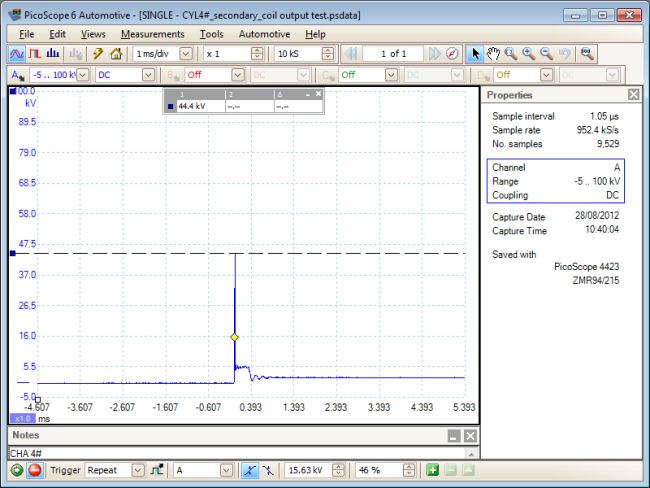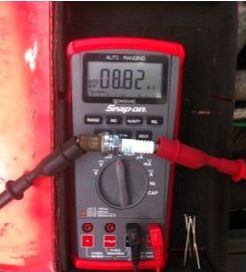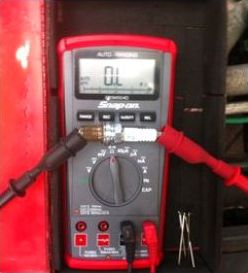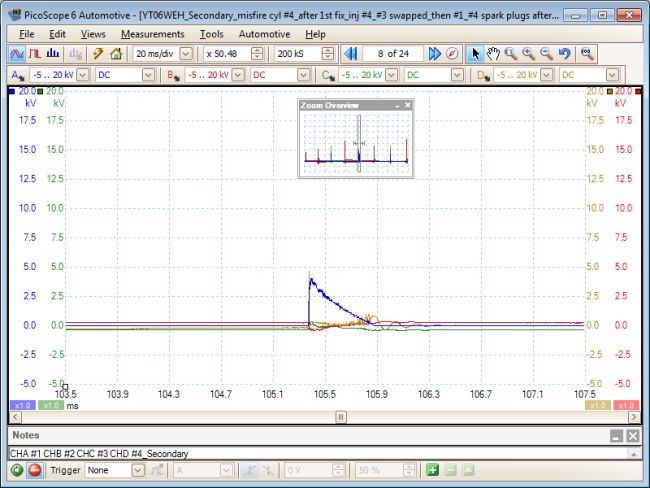
PicoScope 7 Automotive
Available for Windows, Mac, and Linux, the next evolution of our diagnostic scope software is now available.
| Vehicle details: | Peugeot 206 |
| Engine code: | KFW |
| Year: | 2006 |
| Symptom: | Engine misfire, Poor starting |
| Author: | Rob Smith, Doncaster, South Yorkshire, UK |

HT Extension Lead
*At Pico we are always looking to improve our products. The tool used in this case study may have been superseded and the product above is our latest version used to diagnose the fault documented in this case study.
When cold starting this car would misfire, but when warm it quickly cleared. No misfires occurred under normal driving conditions.
The first action was to plug–in with the serial scan tools (scan tools used were Diagbox and SP ACR4/G2) to see what DTCs (diagnostic trouble codes) were present. Sadly in this case there were none stored, and a look at live data didn’t reveal a great deal either, so out with the PicoScope.
The first capture I took was the coil primary current on both sides with misfire present on either cylinder #1 or cylinder #4. See Figure 1.

Figure 1: Coil primary current on both sides with misfire present
A misfire can clearly be seen, and the spark burn time seems to have taken place but dissipated too easily to ground. Is this the insulation in the coil pack? The spark plug? Or an in–cylinder condition? Which cylinder is it?
The next step was to hook up the Coil–On–Plug extension lead kit I recently purchased as secondary analysis was required to pinpoint the offending cylinder (see Figure 2).

Figure 2: Secondary misfire cylinder 4
It can be seen that cylinder #4 is the misfiring cylinder, but still we need to find out why? Again the spark which was mirrored in the primary capture from this secondary is going to ground, it’s time to find out why!
I zoomed in on cylinder #4 to take a closer look, Figure 3.

Figure 3: Cylinder #4 zoomed
I also noticed that being a DIS (Distributorless Ignition System) waste spark that the spark on the waste stroke was intact, so is the coil performing under pressure?
My next step was a coil output test, Figure 4.

Figure 4: Coil output test
This test shows that the coil made around 45 kV with some residual energy left after the burn time, which at this time I am happy with remembering that there is no misfiring under normal driving conditions. So, where to now?
Looking at the downward sloping burn line with no residual energy left (coil ringing) a possibility is high resistance in the secondary, a short to ground, or no fuel (Hydro Carbons) which we all know to be a conductor, but I didn’t really see anything in the coil current ramp that jumped out as a short?
I took out the cylinder #4 spark plug along with cylinder #1 and decided to test the resistance with my DMM (Digital Multimeter), after all I do this with plug leads so why not a spark plug?
Figure 5 is the reading from plug #4 and Figure 6 is the #1 plug!

Figure 5: Cylinder #4 plug

Figure 6: Cylinder #1 plug
With the results of that resistance test I can see that cylinder #4 spark plug has resistance to ground and cylinder #1 spark plug does not.
So it is narrowed down to a spark plug issue on cyl #4. Just to confirm my thoughts I swapped cylinder #1 spark plug and cylinder #4 spark plug over, then recaptured the secondary, see Figure 7.

Figure 7: Secondary misfire with swapped plugs
The misfire follows the spark plug. An after fix capture was taken from cold start to confirm the fix, see Figure 8.

Figure 8: Scope trace showing no fault (after fault corrected)
A new spark plug cured this, a full set was not fitted as I service this car myself and the plugs had not been in that long, so I was more than happy to replace the defective one.
My thoughts as to the misfire clearing quickly were that when the plug heated up the internal part of the plug that was shorting to ground was expanding, and not making any further contact to the body of the plug until it cooled again and the same process repeated itself.
I think the hardest part was the condition to catch the misfire as waiting for a cold start was the biggest pain, along with the shift pattern that the owner worked and getting the car was like getting blood from a stone!
This job also came at the right time as I wanted to try the HT extension leads out that I recently purchased, these helped me no end as without I could not have guessed the offending cylinder by just primary alone.
Once again without the PicoScope and accessories this job would have been guess work and swaptronics…
Peter
May 22 2013
Fascinating article, thank you very much for posting. In tech, they taught us the primary mirrors the secondary voltage waveform, but, as you say, being able to see the secondary in decent resolution reveals those small discrepancies that we are looking for. Noticed some confusion on resistances in comments. A multimeter reading O/L in ohms scale is Infinite resistance. Not ‘No resistance’ as No resistance indicates zero resistance or a direct short. E.g. there is ‘no resistance’ from a point on plug body to another point on plug body. There should be ‘infinite’ resistance from body to centre electrode on a healthy plug, and usually a K ohm resistance between terminal to centre electrode to counter radio frequency interference.
phil j
January 12 2013
Regarding scope settings wouldnt it be clearer if the four channels were offset rather than superimposedf over each other on the primaries?
personally i find it difficult to separate them dislayed like that.
Don Smithson
November 04 2012
I really do not believe what I am reading spark plugs with a resistance reading to earth and still firing. So a electrical voltage going to earth before crossing the internal air gap in the spark plug and still firing across the spark plug gap in the cylinder showing a high voltage on the scope. You learn something new every day. REALLY
Stuart Duff
November 01 2012
An interesting and thorough approach to a common issue with modern coil packs, the process quickly tracked down the offending plug and gave the right and most cost effective repair for the customer, yeah we could swop plugs and coil packs and see if the fault moved, but its good to have a methodical process of analysis and elimination especially when the fault was only when cold.
Great post.
Robski
October 30 2012
@ Marny
These vehicles are prone to coil packs, should I have thrown one on just to see or pinpoint the actual fault in hand ?
Originally the first fault was an injector on the same cylinder due to the well known washer jet/pipe leak issue, I thought it more interesting about the shorted spark plug.
Of course I took them out to have a look which turned out to be a fruitless exercise as A) they had not been in long & B)if the problem is internal to the plug what am I going to see ?
so back in they went & on the scope went.
I wonder how many would have fitted a coil with no testing ?
Darren Cotton
October 30 2012
Nice work…. Not sure if the previous posters have understood what they have read….
I have never given it a thought about plug resistances, But when I read this I got a plug and checked the resistance. This is from the terminal tip to the centre electrode mine was 5.2kohms obviously terminal tip to the body of the plug has No resistance as the plug has a ceramic insulator.. Nice approach.
A visual inspection of the plug does not mean its OK, Its takes experience to know what to do with the tools you have and with no fault codes many would have either thrown some parts on and got lucky or given up! I don’t see anything wrong with your approach, you have proved and identified the fault, with no unnecessary parts fitted…. Look forward to you next study…
Darren
Stuart Bell
October 30 2012
I agree with Darren on this. Sometimes you have to take a thorough approach to get to the root of the problem. I have just had a misfiring C3 through my ‘shop, and the frustration of not being able to test the cartridge coil pack on these (I don’t have coil/plug extension leads) was awful. I could test pretty much everything else with my 4-ch Pico, sadly not the secondaries. I’ve also learned from bitter experience that throwing new parts onto PSA engines, especially the cartridge coil packs, can just confuse the situation, as the replacement is usually just as bad the original!
Doing a resistance check on all plugs has been part of my procedure for this sort of work for the last couple of years, as I’m seeing more and more cars misfiring on “new” plugs.
Andy_R
October 29 2012
Nice find. A quick comment regarding resistances and the interpretation. 8.8MegaOhms is lots of resistance. The comment that the No.1 plug doesn’t have resistance is incorrect, it has lots of resistance. the measurement is more a reflection on the limitation of the multimeter being used. O/L just means that the reading taken is higher than the maximum reading the instrument is capable of. I don’t know what this is, but it might be 20MegaOhms.
Robski
October 29 2012
Hi Andy, you will find i said resistance to ground (earth electrode/plug body from the nipple or nipple to the block)so with this short & a positive fired plug where will the spark go ?
Yes the plugs do have resistance from the screw on or fixed nipple at the top to the center electrode of 3.9 Kohm (the plugs fitted)
I would be interested if you could supply the specs of resistance in a typical spark plug,Cheers
Marny
October 29 2012
Why did you not do a visual inspection of the spark plugs first? That would have saved you an awful lot of time & money to find & rectify the fault. Sometimes & usually more often than not, experience is far more valuable than any tool!